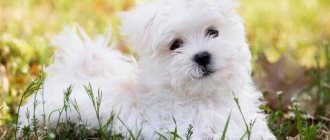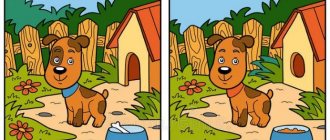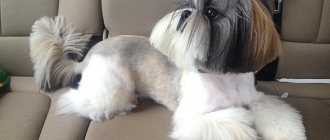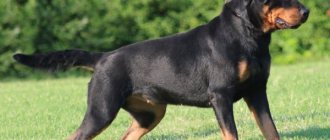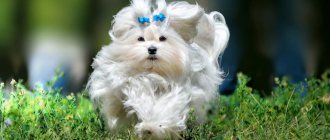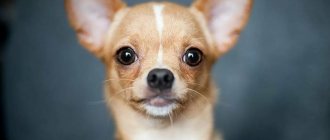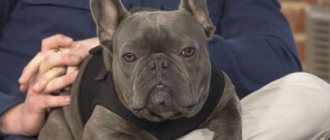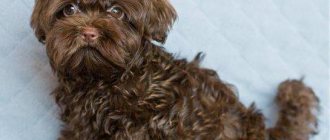More and more people are keeping miniature dogs as pets. A mini Maltese dog could be an excellent option. This breed is famous for its excellent appearance; the puppies generally resemble a plush toy. In addition, the pets are very friendly and affectionate.
The small size of the Maltese allows it to be kept in an apartment without any problems.
History of the Maltese breed
Maltese
The history of the origin of the Maltese is full of hypotheses and assumptions and almost not a single reliable fact. According to experts, the glorious Maltese family is more than two thousand years old, and it’s not hard to believe, since the first images of big-eyed fluffies can be found in the drawings of the ancient Egyptians. As for the name of the breed, the lapdogs owe it to a geographical error.
At first, the animals were called Melites - in honor of the island of Meleda in the Adriatic Sea. However, this piece of land had a “twin brother” - today’s Malta, also called Meleda. At that time, there was simply no one to record the difference between these two islands, so they preferred to forget about it. Later, the Melite was renamed the Maltese, without paying attention to the fact that the real homeland of the animals was not Malta.
The breed's earlier history is no less controversial. In the debate about how the ancestors of the Melites reached the Adriatic coast, scientists reach the point of absurdity. Some experts attribute to lapdogs a relationship with the Tibetan terrier and a journey along the Silk Road from Asia to Europe. Scientists prefer not to mention that the above-mentioned route was not popular two thousand years ago. The version about the Swiss roots of the Maltese looks relatively plausible: in ancient times, the inhabitants of the Swiss Alps actually bred Spitz-shaped dogs that looked similar to today's lapdogs. Some researchers are trying to fit Melit poodles that lived on the islands of the Adriatic Sea into the pedigree, although these two breeds have nothing in common.
Maltese puppy
The popularity of Maltese dogs flourished during the Middle Ages. Most of all, France and Italy were in awe of glamorous pets. The Maltese fashion reached the shores of Foggy Albion only in the 16th century, and even later to America.
Famous owners of Maltese dogs:
- Susan Sarandon
- Patricia Kaas,
- Elvis Presley,
- Barack Obama,
- Elizabeth Taylor,
- Alla Pugacheva,
- Cindy Crawford.
Origin story
Scientists have not been able to find out the exact history of the appearance of the breed. There is a hypothesis that the Maltese is a dog breed that has its roots in ancient times.
And the dogs depicted on ancient Greek vases looked like lapdogs. In those days they were called Melite lapdogs, living on the island of Meleda. Next door to it was the island of Malta, which was identical to the island of Meleda. Later, the island of Meleda was forgotten, and the Melites began to be called Maltese lapdogs, although their homeland was not Malta.
The peak of popularity of these lap dogs occurred in the Middle Ages. She won the hearts of aristocrats. The presence of such a dog indicated great material wealth and high status in society. Women carried their pets in their arms or in special bags. At the end of the 19th century, the breed was brought to France. Many royal people, for example, Queen Victoria and Mary I Stuart were fans of this breed.
Such great popularity of the breed gave impetus to the development of special nurseries. Among noble ladies who showed off their dogs, individuals of smaller weight and size were valued. Since the ladies’ hands were very tired during the social event. Breeders have developed a separate breed of mini Maltese. These mini lapdogs were much more expensive, but were more comfortable and more prestigious than the standard Maltese lapdog.
Appearance of Maltese
Maltese dog after grooming
The breed characteristics of Maltese dogs are fixed by the standards of three cynological associations. For example, domestic breeders trust the standard of the International Canine Federation (FCI) more. In England, they prefer the set of characteristics approved by the UK Nursery (KC). The fluffies living on the other side of the Atlantic have their own standard, developed by the American Kennel Club (AKC).
For your information: American Maltese are very different from their European relatives. Transoceanic lapdogs weigh less (ideally up to 2.7 kg), their coat is much shorter, and their muzzle is slightly narrower than allowed by the FCI standard.
A separate caste consists of the so-called mini Maltese and baby-face Maltese. In the first case, these are miniature individuals weighing from 1.5 to 2.5 kg, which are more common among “Americans”. Babyface puppies are born to both American and European lapdogs. Their distinctive feature is a shortened muzzle, giving the dog a touching, deliberately childish appearance. Such animals are not allowed at exhibition events, but among Maltese lovers they are in high demand precisely because of their “photogenicity.”
Mini Maltese
American Maltese
Head
The Maltese skull is ovoid, of medium size (mesocephalic gradation), with well-developed brow ridges. The back of the head is flat, with a barely noticeable occipital protuberance. The parietal area is slightly convex, the line of the forehead is parallel to the line of the muzzle. The median groove is almost invisible.
The Maltese's muzzle accounts for ⅓ of the length of the entire head. As it moves away from the base, the muzzle gradually narrows and its tip becomes rounded. There is a pronounced stop between the forehead and nose (about 90°).
Nose
The face of a Maltese dog
The nose is straight, covered with long hair reaching the lower jaw. The lobe is large, moist, with well-opened nostrils. In individuals that meet the standard, the lobe is black, not slanted and does not protrude beyond the bridge of the nose.
Lips
The upper lip resembles a semicircle in outline and hangs slightly over the lower one. The Maltese's lips are black and covered with fur.
Teeth and jaws
The jaws are well developed, but not massive. The bite is complete, scissor-shaped, the teeth are strong and white.
Eyes
The purebred Maltese has large, round and slightly protruding eyes. The ideal iris shade is dark ocher. Eyelids with black edging, tightly fitting. The look is lively and open.
Ears
Maltese
Hanging type, close to the muzzle, in the shape of a triangle with a wide base. Standing tall. The fur on the outside of the ear is thick, reaching to the shoulders. When excited, the ears may rise slightly.
Neck
Hidden under abundant fur and held almost vertically. The length of the neck is approximately equal to the length of the head.
Frame
Deep chest with moderately curved ribs. The withers are not clearly expressed, the loin is smooth and strong. The groin areas are located quite low and slightly tucked up. The Maltese's croup is wide, even, with a slight slope in the tail area.
Limbs
The front legs of the Maltese are straight. The shoulder blades are movable, set at an angle of 60-65°. The shoulders are longer than the shoulder blades, inclined at an angle of 70°. Elbows pressed tightly to the body, looking straight. Turning the elbow outward or inward is considered unacceptable. There are rich featherings on the back of the forearms. The pasterns are almost vertical and strong. The paws are round, abundantly hairy, with black pads. Long hair grows between arched, balled toes.
The hind legs are straight. The hips are dense, prominent, slightly tilted forward. The legs are bony, the hock joints are normal with an angle of 140°. When viewed from behind, an imaginary line drawn from the hock to the floor should be vertical.
Tail
The Maltese's tail is a logical continuation of the dog's croup. In a calm state, it is gracefully curved and the tip touches the back (sometimes the standard allows for a slight deviation of the tail to the side). The tail is covered with soft hair that hangs over one side of the body. Ideally, the dewlap of the tail should reach the hock joints and, mixing with the hair on the body, form a lush cascade.
Satisfied Maltese
Wool
Maltese with long hair
Light, straight, flowing like a mantle. The undercoat is weakly expressed and almost invisible. In purebred lapdogs, the hair has a silky texture and is thick. The normal length of a Maltese coat is 20 cm or more. The coat should be smooth, outlining the contours of the body. The presence of protruding tufts of hair and so-called fringes is unacceptable. The exception is the back of the front and hind limbs. Here combs have a right to exist.
Color
The standard color of Maltese dogs is white. Not ideal, but an acceptable color option is ivory. Individuals whose coat has a pale orange tone are considered defective and are not included in exhibition events.
An interesting fact: until the beginning of the 20th century, most cynological associations allowed variability in Maltese colors. It was only by 1913 that a unified breed standard was approved, recognizing only individuals with white hair as purebreds.
Defects and vices of the breed
It is customary to classify as defects in appearance everything that does not fit into the framework of the breed standard. Deviations can be either mild, such as wrinkles on the head or a narrow croup, or serious, affecting the pet’s exhibition “career”. The main defects that threaten a Maltese dog with complete disqualification:
- disproportionate head;
- depigmented nose;
- bend of the back of the nose;
- severe undershot or overshot;
- eyes of different shades;
- pink eyelids;
- cryptorchidism (improper placement of the testicle);
- short tail;
- markings on fur.
Incorrect movements of the dog can also be a reason for disqualification. This is especially true for lap dogs with a Pekingese gait (amble), which do not push off from a horizontal surface, but simply rearrange their limbs. A healthy dog should move at a fast trot. Representatives of this breed have a short and energetic stride, so a Maltese rushing about its business resembles a rolling ball.
Breed standard
The mini-lapdog has a proportionally developed body, and it moves smoothly and gracefully. Description of the dog:
- Head. The oval head is medium in size with a slightly elongated and widened skull. The top is flat.
- Jaws and teeth. Maltese dogs have well-developed jaws and a full scissor bite. Teeth are strong if you take care of them.
- Nose. A small nose with a black and large nose.
- Eyes. Small round eyes with dark brown irises. In a classic lapdog, they should not be deep-set or, conversely, convex.
- Ears. The lapdog has triangular ears, they are slightly raised and fit tightly to the head.
- Neck. The breed has a well-defined neck; there should be no folds on it.
- The body of representatives of this breed is quite narrow and slightly elongated. But the length of the body is greater than the height at the withers.
- Limbs. The Maltese's paws are straight and sinewy, they fit closely to the body, and are of medium length. The paws are rounded and the toes are well grouped.
- Tail. The high-set tail is arched, quite thick at the base and thin at the end.
- Wool. Puppies are famous for their long and dense coat, which is very pleasant and soft to the touch. American representatives have much shorter fur than their English counterparts. There is slight shaggyness on the limbs.
- Color. Maltese puppies are snow white in color. Although in some cases they may be a slightly pale ivory shade, this is not considered a deviation. Platinum wool is obtained as a result of grooming. But any stains or other shades are considered defects.
- Disqualifying faults. Complete disqualification threatens pets with a disproportionate head, severe underbite or underbite, a short tail and marks on the fur.
Note! It is better not to have miniature Maltese or mini terrier dogs in families with small children, as they can injure the pet during play.
In winter, the lapdog needs clothing - its wool is not able to provide warmth
Photo of an adult Maltese
Personality of the Maltese
The Maltese is a perky fidget that just needs to stay in the thick of things and keep abreast of all the news. Moderately friendly, but at the same time confident in their own exclusivity, Maltese will never conflict with pets. In dogs of other breeds, these energetic fluffies see, if not friends, then at least playmates with whom they can run and play around to their heart's content. But lap dogs do not intend to share their master’s attention with any living creature. As soon as the owner of a Maltese pets another animal, a little jealous person awakens in his pet, capable of any meanness towards his opponent.
Maltese with his owner
Despite the fact that the Maltese breed is usually considered as a family breed, bringing an animal into a house where there are small children is at least unwise. Of course, the Maltese has a peaceful disposition, but his patience is by no means unlimited. Dogs have rather strained relationships with strangers. For a Maltese, any unfamiliar person is a potential enemy who should be frightened in advance and properly. Usually, the owner learns about the arrival of an unwanted (from the dog’s point of view) guest by the pet’s choking bark. In this way, lap dogs show their wariness and suspicion towards a stranger.
White and fluffy on the outside, the Maltese, unfortunately, does not always remain so on the inside. The main negative character trait of lapdogs is considered to be stubbornness. If the dog finds the training useless, it will be difficult to convince him otherwise. Another dark side of the breed is the fear of loneliness. If you are used to leaving your pet alone for more than an hour, get ready to accept the chaos in your apartment as a given. Finding itself in a stressful situation, the dog will try to cope with the phobia in its own way, that is, chewing wires, scratching shoes and making puddles wherever possible. Otherwise, the ex-Melitas are quite good-natured and flexible creatures. They just need a little more affection and attention than representatives of other decorative breeds.
Video
* We invite you to watch a video about the Maltese . In fact, in front of you is a playlist in which you can select and watch any of 20 videos about a given dog breed by simply clicking on the button in the upper right corner of the window. In addition, the material contains quite a lot of photos. By looking at them you can find out what a Maltese looks like.
In this article:
|
Rate the material!
[Total votes: 2 Average: 3.5]
The Maltese is an ancient dog breed native to the Central Mediterranean. Companion to Roman Caesars, Cardinals, Kings, Chinese Emperors. This is the dog of modern society ladies, an accessory for prestigious parties, which does not prevent her from reciprocating every fan, regardless of his social status.
Training and education
Don't give in to the Maltese's natural charm and don't neglect your dog's training. Lap dogs, whose whims are constantly indulged, quickly begin to become openly impudent. It is better to teach snow-white pets the basics of etiquette from the very first months of life, and you should not expect great obedience from representatives of this breed. Yes, Maltese are quite smart dogs, but discipline is clearly not their strong point.
Maltese dogs are raised using positive reinforcement: the pet must understand that at the end of the training process it will definitely receive a treat. In this case, it is useless to put pressure on the dog’s conscience. The absence of a tasty reward at the end of the “lesson” is regarded by the animal as deception, so next time the Maltese will simply ignore your call to study.
It is very important to develop the correct reaction in the puppy to the command “Come to me!” This is due to the fact that during walks without a leash, Maltese lap dogs go into “research mode”. The animal is constantly distracted by external factors: it disappears into the bushes in search of the source of an unusual smell, looks into abandoned buildings, and so on. In such situations, the command “Come to me!”, pronounced in a stern tone that does not tolerate objections, is the only way to return the pet to reality.
Important: Maltese puppies under three months should never be punished. The exception is extremely stubborn individuals who do not respond to prohibitions, as well as demonstratively and systematically violating them.
There is no point in getting involved in serious training of a Maltese. This is a decorative breed, intended more for decorating the interior and creating home comfort than for routine service. The only thing that needs to be worked on is the dance and acrobatic performances, which are truly funny in Maltese dogs. But keep in mind that learning one simple dance can take weeks, or even months, so be patient and have a bag of treats in advance to stimulate the four-legged artist.
Running Maltese
Maintenance and care
Due to their miniature build, Maltese dogs feel free and comfortable even in small apartments. Equip your dog with a secluded corner with a bed away from drafts and sunlight, and he will be immensely happy. Maltese puppies have fragile bones, so they need to be handled as carefully as possible. In addition, restless furries love to stick their noses into the most unexpected places in the apartment, which is why it is easy to step on them. The best way to protect your baby from accidental injuries in the first months of life is to fence off his habitat with a small enclosure where you can place a toilet.
Things your Maltese will need:
- bed or house;
- combs for combing;
- nail clipper;
- squeaky toys (Maltese love them);
- leash with collar or harness;
- ceramic or metal food bowl.
Walks
Maltese in a winter jacket
When it comes to walks, the Maltese is not picky and willingly contents itself with short outings “out into the world.” While the puppy is small, often take him out to places where other dogs (not strays) walk. This will make the socialization process faster. Usually, after several promenades, the baby stops seeing four-legged strangers as a threat and relaxes. By the way, spending both a puppy and an adult dog in the fresh air should be dosed: Maltese dogs are not designed for long walks and get tired quickly.
The average duration of a walk for an adult Maltese is 15-20 minutes. In cold weather and the off-season, pets are walked in clothes. So, when preparing for winter excursions, take the time to visit stores that sell shoes and clothing for dogs.
Hygiene
The Maltese is a breed for perfectionists. And although lapdogs are known among breeders as neat and clean pets, their glamorous appearance is 99% the result of the owner’s work. Accordingly, if you are not ready to bother with daily combing and regularly visit the groomer, it is better not to buy a Maltese dog.
Maltese after washing
Animals are allowed to be washed once a week using shampoo and conditioner. After the “bath,” the wool is dried with a towel and a hairdryer, after which it is wound on curlers made of tissue paper. Such manipulations help protect hair from contamination and tangling, and also improve its structure. To prevent an overly excited animal from tearing off its curlers, you can put special socks on its hind legs.
To make the coat silky, breeders recommend using leave-in oils from a veterinary pharmacy, which must be applied immediately after washing. Another effective way to avoid tangles is a silk jumpsuit. The smooth fabric of the suit protects the Maltese's hair from creasing and tangling, thereby simplifying the process of caring for your pet.
The lapdog is brushed every day. First, the hair is separated by hand, paying special attention to the stomach and armpits - areas where the hair often gets tangled. Then the animal’s “fur coat” is sprinkled with talcum powder and a fine-toothed metal comb is passed over it. It is better to gather the long “bangs” on your pet’s head into a ponytail and secure it with an elastic band.
If your Maltese is not going to participate in exhibitions, you can cut his hair, which will save you a lot of time. In addition, it is necessary to regularly trim the hair between the toes, as well as around the dog's anus and genitals.
Maltese dogs have very sensitive eyes, which also often water, leaving unsightly dark grooves on the face. To prevent this process from evolving, excess natural mucus in the corners of the eyes is removed with a cotton swab. Some breeders recommend wiping lapdogs' eyelids with tea infusion or chamomile decoction, but this method also has opponents who claim that such homemade lotions are of very little use. In addition, due to too frequent use of herbal infusions, the hair around the dog’s eyes begins to fall out, which can become a reason for the disqualification of the animal from the exhibition.
Caring for the ears and teeth of a Maltese is no different from caring for any other purebred dog. The ears of lapdogs are examined once a week, removing dirt accumulated in them using lotion and a cotton swab. Teeth are brushed once every 7-14 days with a soft brush with veterinary paste applied to it. If your lapdog has tartar, contact your veterinarian who will solve the problem quickly and professionally. Pay attention to your dog's nails twice a month. The best option is to remove the excess plate with a nail clipper, and then sand the remaining part of the claw with a nail file.
Feeding
I found something tastier than food!
The Maltese dog can be fed natural food, but it can also be fed dry food. In any case, the main thing is not to overfeed, if you don’t want to one day find a hulking furball at home suffering from shortness of breath. Half of a dog's natural diet should be meat. The remaining 50% of the daily menu comes from cereals (rice, buckwheat), vegetables and fruits. Once a week, meat can be replaced with offal or boiled sea fish. Fermented milk products should also be present in the Maltese’s diet. Several times a month, you can treat your pet to quail yolk mixed with vegetable oil. Another variety of delicacy that is useful in all respects is walnuts with a drop of natural honey.
How to feed: lap dogs are fed four times a day for up to six months. At 6 months, the number of meals is reduced to three. One-year-old dogs are completely transferred to two meals a day.
Like most other breeds, Maltese are extremely harmful to smoked foods, sweets, potatoes and legumes. It is recommended to include sharp cheeses, pickles and cabbage in the same list.
Dry food for Maltese dogs should be selected individually and preferably in the company of a veterinarian, since some industrial varieties of “drying” can provoke allergies in the dog. Your pet’s eyes, which begin to water excessively if the food is chosen incorrectly, will help you understand that it’s time to change the diet.
Maltese dog - care and maintenance
In order for the whole family to enjoy the acquisition of a new pet for many years, it is important to provide proper care for the Maltese at home. It includes:
- Raising, training and socializing a dog.
- Regular walks and exercise.
- Daily care for coat, eyes and ears.
- The Maltese needs to be cut periodically, preferably in specialized salons.
- Choosing the right diet.
- Preventive vaccinations and examinations by a veterinarian.
What to feed your Maltese?
Proper nutrition of the Maltese can be organized according to two schemes:
- dry food;
- natural products.
When feeding dry food, it is worth buying specialized food for small breeds of dogs, super premium class or holistic. For example, Royal Canin, Akana, Grandorf, Hills. When choosing this type of food, dogs need to buy additional vitamins recommended by a veterinarian and special treats to clean their teeth and strengthen their chewing units.
Experts do not recommend mixing dry food with natural food. If a decision is made in favor of the latter, then the Maltese dog should regularly receive:
- lean meat;
- offal and cartilage;
- boneless fish;
- fermented milk products;
- eggs;
- cereals;
- vitamin complexes.
How to wash a Maltese dog?
Maltese puppies need to be taught to bathe from a very early age. You need to wash your dog at least once a week. If your pet gets dirty during a walk, you can also bathe it, but frequent walks in dirty weather are not recommended. The bathing stages consist of:
- Applying a special silky shampoo to maintain the structure of the coat, for example, ESPREE Bright White Shampoo or Crown Royale.
- Using a leave-in balm, for example, MATTLESS, to make combing easier.
- After bathing, the fur is gently blotted with a towel.
- Some breeders additionally apply a leave-in coat oil, such as SHOW OIL.
- After the procedure, it is permissible to dry the dog with a hairdryer with cool air, winding the hair on special curlers.
Maltese dog grooming
Regular haircuts are required for this breed. Their frequency varies from three per week for show dogs to once every two months for regular pets. A Maltese haircut will look more advantageous if done by a professional. The groomer will select the optimal hairstyle depending on the class of the animal and the wishes of the owner:
- Mouton or “puppy style”
is suitable for pets in the summer. - Hygienic
involves removing hair in especially dirty places and giving the dog a well-groomed appearance. - Korean style or kawaii
is a very fashionable and at the same time popular technique, the implementation of which should be trusted to a professional groomer. - Exhibition haircut
involves maximizing the preservation of the length of the coat with easy alignment of especially stray hairs.
Maltese - hairstyles
Often on the streets you can see a shorn Maltese dog with additional decorations on its coat. Hairstyles are similar to Yorkshire Terriers due to identical standards:
- As a hairstyle, the owners use special accessories to pin up the dog's distinctive bangs - the hair on the frontal area of the head.
- Some go further and decorate the pet’s back with accessories, collecting long and silky hair with special bows in tails.
- To add a slight wave, groomers can, at the owner’s request, braid Maltese hair.
How to raise a Maltese dog?
Due to its lively disposition and sharp mind, the Maltese dog breed requires mandatory training and socialization:
- The puppy should often walk in specialized areas, getting used to interacting with other dogs and people.
- From the first day a puppy arrives in the house, it is important to establish rules and boundaries of what is permitted. Don't be allowed to play pranks because of your cute appearance.
- Training should begin at the age of 2-3 months. Maltese is quite capable of learning basic commands, but due to her stubbornness, this process cannot be called quick.
- Harsh training and rough treatment are not acceptable. Until the age of one year, you need to exercise with your pet every day for at least an hour, turning the training into an interesting game.
Maltese Health and Diseases
Maltese on a walk
The most common ailment of Maltese dogs is eye diseases such as glaucoma, blocked tear ducts, retinal atrophy and distichiasis. In addition, the Maltese inherited a tendency to dermatitis and deafness from its ancestors. Hydrocephalus, hypoglycemia and heart disease are often found in Maltese dogs, which can be treated with medication in the initial stages. But congenital subluxation of the patella can only be eliminated surgically, so before buying a puppy you should pay attention to the condition of its limbs.
How to choose a puppy
The first and main rule when choosing a Maltese puppy: the animal must fully comply with the breed standard. This means no discounts for malocclusion, “small” breasts and other defects. Carefully evaluate the condition of your future pet's coat. Since Maltese dogs have oily and dry skin types, the hair structure of each individual individual will be very different.
The most common buying mistake is choosing the fluffiest puppy from the litter. Of course, such animals look prettier than their fellow tribesmen, but too much wool for a Maltese is more of a disadvantage than an advantage. There is no need to be afraid of puppies with slightly wavy hair. With age, the animal's fur gains strength and straightens. At the same time, it is necessary to distinguish dogs with wavy fur coats from truly curly pets. Maltese puppies with pronounced curls of fur are a real Plembrak.
Photos of Maltese puppies
How much does a Maltese dog cost?
In domestic nurseries, a purebred Maltese puppy can be bought for 25,000 - 30,000 rubles. Individuals with an exotic appearance like mini Maltese and baby-face Maltese are much more expensive: on average from 35,000 to 45,000 rubles. You can buy a snow-white fluffy from your own hands for 10,000 - 15,000 rubles. The relatively low cost in the latter case is an indicator of the risk the buyer is taking. Not all puppies sold through virtual bulletin boards have a pure pedigree and fit within the breed standard.
Maltese - pros and cons of the breed
From breeders, Maltese puppies look like cute little toys that you just want to buy for yourself or as a gift for your child. However, before purchasing, you should carefully evaluate the pros and cons of the breed and your ability to care for it. Cynologists include the following advantages of the Maltese:
- Compact sizes.
- Peaceful and good-natured disposition.
- Ability to get along with small children and other animals.
- Sharp mind and ability to learn.
- Hypoallergenic.
- Good health provided proper crossing and care.
The Maltese dog also has significant disadvantages that should be considered before purchasing:
- Increased activity, requiring regular walks and activities.
- High-pitched and often causeless barking.
- Bolonki cannot tolerate being alone.
- They need careful and high-quality coat care.
- They can be picky eaters and prone to obesity.
Does a Maltese shed?
Many potential breeders are interested in the issue of shedding in the Mini Maltese. Veterinarians claim that such a dog sheds in stages, that is, there are no sudden jumps and tufts of fur around the apartment. Considering also that you need to comb your pet’s fur every day, this process goes almost unnoticed. During the molting period, show dogs are still capable of losing their decorative appearance, which is quickly restored in a few weeks.
